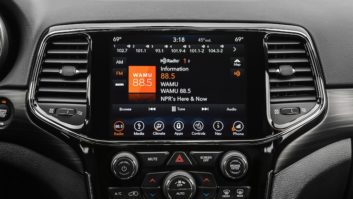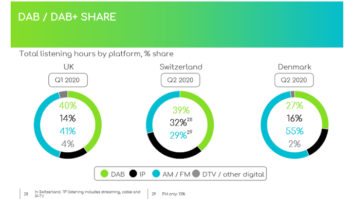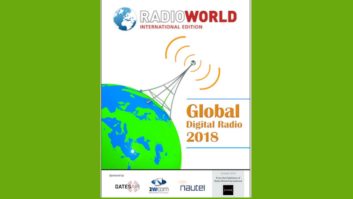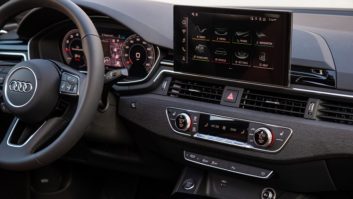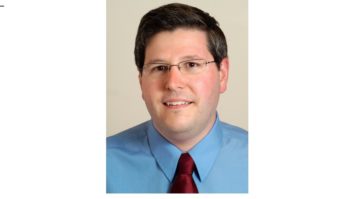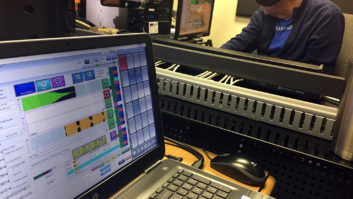It’s safe to say that the introduction of digital radio technologies around the world has had a rough road. Although a few countries have succeeded in deploying viable digital radio services, most have experienced very slow adoption by consumers or are still considering their options about which systems to implement.
Two presenters at the Broadcast Engineering Conference of the spring NAB Show shared their perspectives on the state of digital radio worldwide and what broadcasters and regulators need to consider as they move to adopt new digital radio services in their countries.
(click thumbnail)In a paper at the NAB Show, Charles Kelly of Nautel depicted the FM spectrum in Taipei, Taiwan. ‘Between 88 and 89 MHz, there are four educational FM stations which are spaced by only 200 kHz,’ he wrote. ‘The HD Radio sidebands are on top of each other, and it is likely that poor coverage would result, with HD Radio reception possible only where one station has a significantly higher field strength that the adjacent channels. Between some of the stations, such as the ones at 89.3 MHz and 87.7 MHz, there is only 400 kHz separation. Theoretically, this will work, however the reception of one of the sidebands may be impacted if the immediately adjacent sideband is significantly higher in received strength.’ Source: 2008 NAB Broadcast Engineering Conference ProceedingsCharles Kelly of Nautel Ltd. has analyzed the effect of existing band plans and allocations on the technology choices available to countries as they consider which in-band digital radio system to authorize. The suitability of specific systems for a particular region largely depends upon the existing regulatory conditions, channel spacing and usage of the AM and FM bands, he concludes.
In the medium-wave (AM) bands, broadcasters have a choice of two in-band systems: Digital Radio Mondiale and HD Radio. DRM is an easily adaptable system with many configuration options, Kelly said, but it requires a vacant allocation for each new digital transmission. HD Radio, on the other hand, occupies an existing analog channel (and its first-adjacent channels), but its 10 kHz channel spacing may be a challenge to implement in countries with fairly congested 9 kHz channels.
Channel allocation considerations
Where there are a large number of available channel allocations, such as in countries where AM stations have gone dark due to limited listenership, the DRM system offers advantages in flexibility and data capacity that make it the logical first choice.
In more congested environments where analog AM listening is still popular, Kelly said, HD Radio may the only viable option, but the risk of first-adjacent interference between stations must be considered.
By way of example, Kelly discussed the results of his analysis of the crowded allocation conditions in Manila, the most populous city in the Philippines. Since there is a station allocated every 36 kHz, HD Radio would appear to work nicely with a 6 kHz guard band between each station’s nearest digital sidebands.
However, a number of closely-spaced first-adjacent stations would likely receive interference to some portion of their current analog coverage area due to the new digital sidebands, as well as limiting the digital coverage of one of the Manila stations at the fringes of its coverage area. For this reason, Kelly recommends that the potential interference effects of any proposed digital system be analyzed to determine the extent of any compromises in coverage that will result when the system is fully deployed.
In the FM band, HD Radio, the FMeXtra subcarrier system and the proposed digital-only DRM+/DRM120 system currently in development are all possible options.
Of these, HD Radio is the most widely deployed, Kelly said, but the other two systems offer much different approaches to in-band digital radio and may be a better fit in certain countries.
In Seoul, South Korea, where the FM allocations are widely spaced, Kelly determined that all existing stations could operate with HD Radio and several new allocations for DRM+ stations were possible as well. In Taipei, Taiwan, however, the allocation spacing is much less consistent, with a number of stations only 400 kHz or 200 kHz apart.
Although some of these stations may be able to deliver a receivable digital signal with one sideband, Kelly explained, a reallocation of several stations would be required to ensure that all the signals could be received without interference. In markets such as Istanbul, Turkey, where stations are allocated every 200 kHz, FMeXtra may be the only option for digital radio service, he said.
Summarizing his findings, Kelly concluded that the operational differences between the various in-band digital radio systems ensure that broadcasters and regulatory authorities will be able to select new technologies appropriate to the specific requirements of their allocation plans and existing stations.
DAB receiver costs
Alexander Zink, presenting a paper authored by his Fraunhofer IIS colleague Olaf Korte, outlined the current status of digital radio technologies in Europe.
Zink readily admits that the experience of DAB (Eureka-147) deployment in various countries has been mixed; it has seen success in the United Kingdom and Denmark, but other countries have ceased DAB broadcasts entirely.
He attributes the slow adoption of DAB to the high cost of receivers in the early years, regulatory impediments such as transmission power restrictions and the lack of unique and compelling programming on the digital channels.
However, he is now optimistic that these challenges have been overcome and that DAB is primed to be successful in more countries, through efforts similar to Germany’s plans for a “Big Bang” rollout of new digital services in 2009.
Part of the reason for this resurgence is the approval of two significant enhancements to the DAB specification in the past several years, Zink said. The first of these is Digital Multimedia Broadcasting, designed to deliver anything from MPEG-4 full-motion video to static images within the bundle of DAB service channels known as an ensemble.
Zink characterizes the service as a great success in South Korea, where it was developed, and reported that DMB is currently in use in Germany and several other European countries. France is planning to roll out T-DMB service for multimedia and to use what it’s terming “DMB Audio” for digital radio services. With a T-DMB-capable phone, users have video and audio services.
The second enhancement, dubbed DAB+, allows broadcasters to use the MPEG-4 HE-AAC v2 audio coding instead of the original less-efficient MPEG Layer II codec, which Zink estimates will enable two to three times as many audio channels to be multiplexed within an ensemble with comparable audio quality as current services.
The first commercial receivers capable of decoding the new audio format will be available soon. Revo, in fact, has a model on the market now. Australia will be the first country to deploy an exclusively DAB+ digital radio service, according to Zink.
Since both new services do not require modification to the core DAB channel coding and can coexist with legacy services in the same ensemble, a clear upgrade path exists for current DAB broadcasters to introduce the new capabilities without facing the costly replacement of existing transmitters.
Still, Zink notes, the biggest hurdle to introducing DMB or DAB+ into markets where DAB already exists is on the receiver side, since current generation receivers are unable to decode either of the new services.
DRM appears to be the clear choice for digital broadcasting on medium-, short- and long-wave bands, since it was designed by an international consortium for exactly that purpose, Zink observed. The biggest problem for DRM continues to be a lack of affordable receivers, although he speculates that the use of DRM in large markets such as Russia and China will help to speed receiver development.
A number of other systems are being used or considered in Europe, Zink reported.
DVB-H is on the air in Italy and is being tested in Germany and Austria. Although it is primarily seen as a video transmission system, it also supports audio-only channels and could arise as a potential competitor to the DAB family of services if support for certain radio data services were included, he speculated.
DRM+ proposes to extend the DRM specification to cover VHF frequencies up to 120 MHz, which Zink theorizes may become an attractive option for broadcasters that have distinct local coverage areas they wish to serve and do not require the higher bandwidth of DAB to support their services.
HD Radio is attractive for its hybrid mode support for analog services, and Zink reports that Switzerland is broadcasting HD Radio services, Germany is testing the system, and many East European countries have shown high interest in the technology.
Both presenters felt strongly that broadcasters the world over benefit from having so many viable technologies to consider as they weigh which systems will be most appropriate for use in their markets. Perhaps the slow pace of digital radio deployment will begin to accelerate as more countries find ways to successfully transition their broadcast services from an analog world to a digital one.






